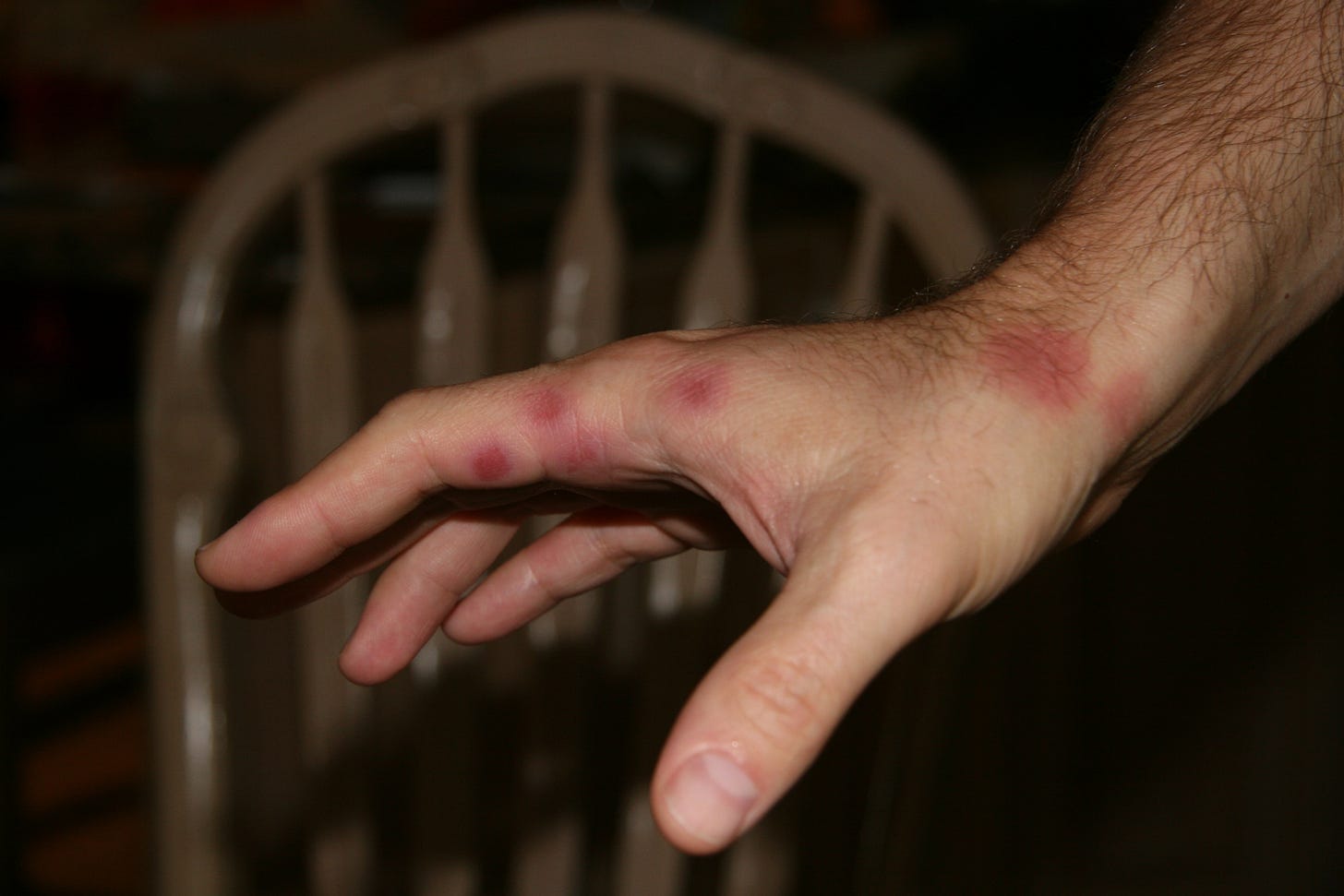The Quinine Conundrum
Mystery Across Continents
The Enigmatic Beginning
In the crisp autumn of 2006, I found myself in the picturesque canals and tulip-laden landscapes of the Netherlands. It was a business trip like any other—until it wasn't. After a delightful dinner of local cuisine, I retired to my hotel room, blissfully unaware of the medical enigma that awaited me. The next morning, I woke up with a swollen lip and peculiar pains in specific points on my left hand.
"Must be something I ate," I thought, brushing off the oddity as a culinary misadventure. I popped some Benadryl and carried on with my meetings and presentations. But by the time I returned home, my hands were adorned with six red spots, and let's just say, other regions were also affected. Intrigued and slightly alarmed, I consulted a dermatologist. The term "Erythema Multiforme" was scribbled on my diagnosis sheet, a phrase I glossed over at the time. I recovered and filed the experience away as a bizarre one-up episode.
The Netherlands Strikes Back
Fast forward to April 2007. Once again, I was flying back from the Netherlands, and déjà vu struck. The same specific pains in my left hand reappeared, only this time, the symptoms escalated. My mouth was affected, making eating a Herculean task, and other, more private areas were also in distress. A different doctor confirmed the diagnosis of Erythema Multiforme and even floated the possibility of it being herpes-related. After a battery of blood tests and a prescription for Valtrex, I was back to normal—but only after a grueling two-week ordeal.
The Plot Thickens: It's Not Just the Netherlands
By July 2007, the mystery resurfaced, but this time in the comfort of my New Jersey home. Despite being on a cocktail of medications, the symptoms were relentless. The only silver lining? It ruled out the Netherlands as the culprit. But the question remained: Why did these episodes coincide with my trips to the Netherlands?
The Mayo Clinic and Other Theories
At this point, I was ready to explore all avenues, even considering a complete observation at the Mayo Clinic. Another theory emerged: Could it be a parasite? A tropical medicine specialist ruled that out, and in a desperate attempt to "reboot" my system, I even tried a Master Cleanse.
The Breakthrough: A Toast to House, M.D.
Just when I was on the brink of despair, my wife, an avid fan of the TV show "House, M.D.," made a startling connection. She linked my symptoms to an allergic reaction she saw on the show (Season 4, Episode 14 — “Living the Dream”), which led us to scrutinize my diet differently. The common denominator? Tonic Water in New Jersey and Bitter Lemon in the Netherlands, both containing the elusive ingredient—Quinine.
The Revelation
In retrospect, the fabric of clues seems almost glaringly obvious, each thread woven meticulously into a narrative that only became clear at the end of this bewildering journey. When the dermatologist first diagnosed me with Erythema Multiforme, the term 'drug eruption' was casually tossed into the conversation. At the time, it seemed like medical jargon—dense and impenetrable. But now, armed with the wisdom of hindsight and a dash of medical detective work, I understand that what I was experiencing was a 'fixed drug eruption.' This phrase elegantly encapsulates the enigma of my symptoms: the spots that appeared on my skin were not random but rather fixed, manifesting in the same locations each time, like a twisted form of déjà vu.
But here's where the plot thickens: there's no standard blood test to diagnose a quinine allergy, at least none that I'm aware of. This leaves a gaping hole in the medical landscape for us negative lottery winners, a sort of diagnostic blind spot that could easily be overlooked. And yet, the most chilling revelation of all lies in the seemingly innocuous beverages—tonic water and bitter lemon. These everyday drinks contain quinine concentrations ranging from 40 to 70 milligrams per liter. While this may sound trivial, it's a proverbial drop in the bucket compared to the quinine (or quinine-like) levels found in malaria prophylaxis medication.
This realization casts a long, ominous shadow over my future travel plans. You see, my wanderlust has often taken me to exotic locales, like the lush rainforests of Costa Rica. In such regions, the risk of contracting malaria is relatively low, so I've always opted out of taking prophylactic medication. But what if my future adventures lead me to malaria hotspots? The rarity of my quinine allergy, compounded by the dearth of scientific data on the subject, has instilled in me a newfound sense of trepidation. I'm now faced with a daunting paradox: the very medication designed to protect me could potentially unleash a torrent of debilitating symptoms or worse.
So, as I stand on the precipice of this medical conundrum, I can't help but feel both enlightened and unnerved. It's a stark reminder that sometimes, the answers we seek are hidden in the most unexpected corners, waiting to be unearthed. And sometimes, those answers raise questions that are even more complex, leaving us to navigate the intricate labyrinth of life's uncertainties.
Final Thoughts
This journey through medical labyrinths taught me the importance of keen observation and open-mindedness. It also made me realize how little we sometimes know about what goes into our bodies. If you've had similar experiences or have insights into rare allergies, I'd love to hear from you. After all, life is a puzzle, and sometimes the pieces fit in the most unexpected ways.
So, here's to solving life's little mysteries, one sip of tonic water—or rather, a sip of something else—at a time.
Disclaimer: This is not medical advice. Always consult a healthcare professional for medical concerns.








Great article and detective work!